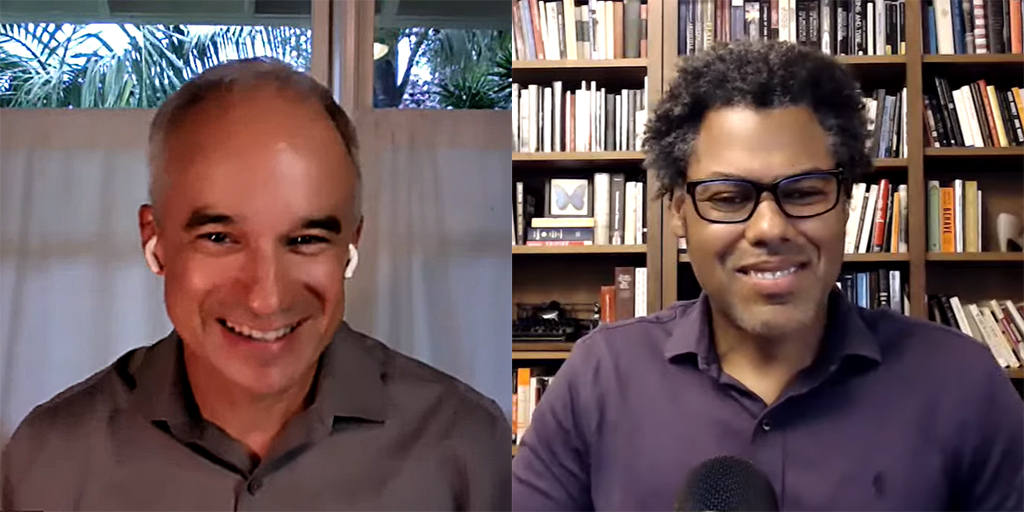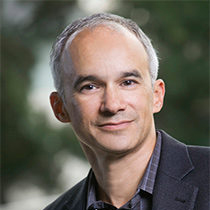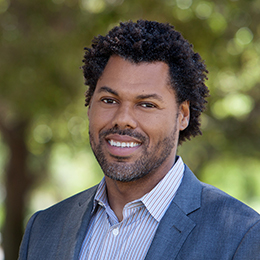

Ian López
Director, Racial Politics Project, Haas Institute for a Fair and Inclusive Society, Chief Justice Earl Warren Professor of Public Law Berkeley University

Brian Lowery
Professor of Organizational Behavior, Stanford Graduate School of Business
This conversation took place on January 18, 2021
Summarized Transcript
Brian Lowery: I’d like to start today by honoring Martin Luther King Jr. with a quote from his last book, written the year before he was assassinated. The book is Where Do We Go From Here?, and the quote is:
“Why does white America delude itself…? They believe that American society is essentially hospitable to fair play and steady growth toward…racial harmony. But unfortunately, this is a fantasy of self-deception and comfortable vanity. As the nation passes from opposing extremist behavior to the deeper and more pervasive elements of equality, white America reaffirms its bonds to the status quo.”
Can you help us unpack what that quote is saying?
Ian Haney López: King is writing at a time when the country outside the South is moving into a mode of backlash against civil rights. Through 1964, there was a perception that civil rights meant ending formal segregation in the South, and there was broad support for that. But by 1967, it was clear that this would require substantive reform in the North, and a backlash was developing. That quote is also relevant today, in 2021, because it’s a quote that asks us to think about whether white America is prepared for equality. As we try to understand Trump-ism and the insurrection of Congress last week, we need to come to terms with what “whiteness” has meant and continues to represent in this country.
Brian Lowery: It might be particularly challenging when individuals having a conversation on whiteness don’t identify, or are not identified, as white. I identify and am perceived as a Black man, I’d love to hear how you identify and think about this conversation — I imagine with a last name like López, individuals identify you as Latinx.
Ian Haney López: I think that’s right and goes beyond that. I identify as Latino, and I think that one of the main attributes of whiteness is the ability to float above, or outside, race. Race is something that people of color have, but not something that white people have which comes with an innocence that white people are not significantly shaped by race. That leads to “white fragility,” or the feeling of anxiety or being attacked when a conversation turns to race. This is something fundamental to acknowledge: we are a country that has been structured in terms of race for hundreds of years, and we’re not going to deal with it unless we can have thoughtful, considered, measured conversations about it. The conversations can be challenging, but they shouldn’t be construed as attacks. The only way to get through this is to open ourselves up to conversations that make us uncomfortable and may be unfamiliar— all human beings are capable of thinking about, processing, and internalizing. Race is something we can make progress on.
Brian Lowery: As a Black man, there’s a sense of pride in belonging to a community that has overcome struggles. What is the positive content of the white category? It seems reasonable that people would feel attacked if all it means to be “white” is to be racist.
Ian Haney López: My dad’s white, and my mother is from El Salvador. I was born and raised in Hawaii until I went to St. Louis, Missouri, for college. When I got there, I was a little browner than most people, but I was articulate and my English was unaccented, so people accepted me. I later realized that I was extended a presumption of “honorary” whiteness. However, that didn’t protect me from police stops or harassment from a few of my fellow students. I came to understand that the categories of “white,” “Black,” “Latinx,” etc., are not rooted in nature; social practices fix them in place. And the social conventions are malleable and continue to shift. The first book I wrote was White by Law, which understands the legal definition of whiteness over 200 years, and understands that the categories continue to shift. Latinx as a race has solidified recently, partly because there has been so much racism aimed at Latinx individuals. What is whiteness as a set of social practices? Whiteness is a set of ideas that says that the lighter one’s skin color is, the better they are — “better” meaning innocent, law-abiding, rational, capable of self-government, hard-working, or decent. In contrast, being Black, or being darker, is inferior — for example, more brutish, less intelligent, thieving, lazy, incapable of self-control or self-government. These are the racist ideas on which a lot of the economy, political infrastructure, culture, and material infrastructure of our society have been built. The concrete of our society has been poured in keeping with these ideas. These ideas have material manifestations, because it’s race’s very materiality that continues to reinforce these ideas. All over the country, there are communities that sit close together that have considerable differences in quality of life — East Palo Alto vs. Palo Alto, for example. One neighborhood has a long history of segregation and disinvestment and is primarily occupied by poor brown or Black people. The other is marked by resources, segregation that favored whites, high levels of education, and high income levels. It’s almost impossible to come away from looking at that and decide social practices must have created this.
Brian Lowery: Is it true that you could eliminate whiteness as an idea without eliminating white people?
Ian Haney López: Many progressives say that there isn’t anything positive about whiteness and that white people need to grapple with guilt for the damage they have done to our society. That’s great as an ideal, and I applaud the whites who can do that. But we should also be clear that very few people can critically look at their identity and retain a sense of self and remake how they position themselves in society. In my first book, I wrote that we need to work against whiteness because nothing is good about it. However, I’ve learned that that advice ensures that whites remain defensive about their whiteness, and the conflict remains. That approach understands people’s orientation towards race to be unified and straightforward. It classifies people within the white category as the problem, and people outside the white category as immune to the problem. Many white people are simultaneously drawing on internalized racism and trying hard not to be racist. Many people of color also draw heavily on norms of whiteness and can perpetuate “lighter is better” or anti-Blackness themselves. Almost all of us have split minds on the understanding that we are influenced by the whiteness hierarchy and understanding that we’re all human and deserve dignity. There’s a pull towards taking the advantages of whiteness, even for individuals who aren’t white, while simultaneously investing in creating a just society.
Brian Lowery: If you’re a white parent who embraces being a good person and creating a just society, what do you tell your kids about being white?
Ian Haney López: First of all, you tell your kids about being white. Even that is radical advice — the norm is color blindness. People say that the best way not to be racist is to never talk about race. But research shows us that not talking about race, especially with children, ensures that we simply absorb racist lessons from society at large. Race is a subject that people believe is obvious because they live it every day. And I often say that just because someone spends money every day, that doesn’t mean that they’re qualified to be an economist. If one wanted to understand the economy and discuss it with their kids, they would read about it or watch some documentaries. One wouldn’t say that they shouldn’t talk to their kids about it out of ignorance. They would say that they need to educate themselves, that this is a field that requires study. Race is also a field that requires study — we’re all living it, but the terms that we’re living it on are full of lies, misinformation, and racist myths. If a white parent were to ask me how they should discuss race or whiteness with their kids, I would say: “I’m really glad that’s your project. Before you start talking, do some learning.” The most important thing is to communicate is that we’re all in this together — we’re situated differently in our society. Race is real but it’s not fixed; it’s human-made. Dr. Martin Luther King Jr. always stressed that every criticism he had about society was built by society — and because of that, we can undo it. We can’t step outside it, but we can fix it.
Brian Lowery: You talk quite a bit about dog whistle politics in one of your recent books. You also talk about how whiteness has a greater force when it’s not consciously acknowledged. Do you think that’s changing? From my perception, it seems like outgoing President Donald Trump was using more of a bullhorn than a dog whistle, so I’m curious what you now think about the importance of not acknowledging race.
Ian Haney López: Yes, it is changing — changing in a very dangerous direction. If you ask people whether they’re sympathetic to the Ku Klux Klan or to white supremacy, usually about 2-4% of the population would say they are. However, if you ask Trump supporters, that number goes up to 4-8%. It’s imperative to be clear that Donald Trump’s strategy is a strategy that’s 50 years old and started in response to the civil rights movement. And two aspects of that are relevant: 1) increasing anxiety and backlash among whites in the face of demands for racial equality, and 2) the acceptance among whites that racial equality is the moral position. What happens is that politicians begin to use language that simultaneously triggers racist fears and is designed to allow people to believe that they are reacting not to racism but to higher principle. In the 1960s, the conversation was about states’ rights when it was, in fact, about the government ordering Southern states to end practices of racial oppression. That is a dog whistle. “Forced busing,” “law and order,” and “welfare queens” are also all dog whistles. This goes back to what whiteness means; there are dog whistles connected to racist stereotypes that don’t outright say that “this is about Black and white.” No one uses racial epithets — instead, they ask, “How do I feel about welfare cheats? How do I feel about criminals?” If you think about Trump’s language, he is very careful about never using racial epithets. If he did, he would only attract that 8% — the fans of David Duke. Even David Duke doesn’t say he’s a white supremacist — he simply says he’s fighting for Euro-Americans’ rights. Trump used language that people believed was common sense, not racism. In national focus groups in 2017, I tested Trump’s messaging on sanctuary cities, where Trump says things like, “We need to take care of our own people first and we need to fully fund the police.” Most progressives would say this language is a bullhorn. Yet, this language was not recognized as racism in my research; it was recognized as convincing — not just by a majority of Republicans, but by a majority of Democrats, union households, Latinx, and African Americans. This is racial demagoguery in code, which has gotten more extreme. There are Latinx and Asian American members of the Proud Boys who feel there is a racial conflict coming and that they can be part of this expansive white team. It’s a mistake to simplify that Donald Trump appeals to bigots — it misses many Trump voters’ complexity and humanity, and misses the ways in which pundits and the Democratic elite believe that dog whistles are common sense.
Brian Lowery: At the Capitol insurrection, the people rioting didn’t see themselves as rioters. They saw themselves as doing the right thing. In your mind, is that tied to the idea of whiteness?
Ian Haney López: It is. I also want to say that people are trying to, often unconsciously, think through what is good for them and their family while also ending racial hierarchy, and this can be very dramatic. If you want to understand the protesters, you have to understand the larger story being told to them by right-wing propaganda, including the GOP, Fox, social media, and white evangelical churches. And they tell a pretty coherent story: one should fear and resent people of color, and hate liberals and liberal government because liberals coddle people of color with government giveaways. Instead, one should turn away from an activist government, support the free market, build walls, and buy guns. If that’s the story you’ve internalized and are constantly fed, then it’s what you’ve come to believe is the way to give your children a better life. They want to fight for decent, hard-working, innocent people whose rights are being stolen by angry minorities and their Democratic enablers. When I was working in focus groups, I tried to tell a different story: a story that said that the real danger doesn’t come from people of different races, religions, or sexual orientation — it comes from demagogic politicians whose main interest is to serve other billionaires like themselves. The main enemies are the few trying to rig our economy and government for themselves. And their main strategy is to promote division about racially egalitarian norms. Instead, building cross-racial solidarity will enable Americans to achieve sufficient political power and enable the government to support the majority of working families.
Brian Lowery: It’s also the case that there are benefits associated with whiteness that aren’t just economic interests — the feeling of yourself as being above or better. When you talk in terms of pocketbook issues, do you think that’s enough? Are people going to be willing to give up those other nonmaterial interests?
Ian Haney López: This approach is not novel — this is the same idea as Martin Luther King’s Poor People’s Campaign. And it’s the idea that we can’t achieve racial justice except through a cross-racial movement that addresses economic inequality and militarism. It’s also the same idea that animated the fusion movement right after the Civil War and said that newly emancipated people had to find and build common cause with poor whites. Are material interests enough? It’s important to look at how whiteness’s material and psychological wages differ between now and 1968. Back then, the material wages of jobs were high, and white people had protected jobs, access to schools, access to employers, and neighborhoods. And at the same time, whiteness’s psychological wages were very high — we were just moving past express commitments to white supremacy and coming to understand that stereotypes about African Americans and Latinos were racist and ugly, and not at all statements of fact. Fast forward to 2021. Materially, wealth from great middle America has been siphoned upwards to the economic stratosphere by people like Donald Trump. We have a federal government that is unwilling to commit to protecting working families, most pressingly affecting people of color. The psychological wages of whiteness had fallen and even reversed due to decades of civil rights activism and, largely, the Obamas. And then came Donald Trump. For the first time in our 400-year history, we have an opportunity to convince a majority of our population that whiteness is a threat to their own children’s lives and that the best route forward is building across racial solidarity. That is only a possibility, though, because we have had big and important changes in the wages of whiteness.
Brian Lowery: What’s the most important thing an individual can do to advance racial justice right now?
Ian Haney López: Wrestle with the idea that racism isn’t primarily a conflict of whites vs. people of color. Racism is a hierarchy of whites over nonwhites. Racism is a weapon of the rich in which the powerful few intentionally promote conflict between racial groups. The possibilities that flow from these ideas will help us get out of the idea that we are locked into a conflict between racial groups. Instead, we need to make it clear that we are all in this together. It’s also imperative to understand that the people who gain from racial conflict are the ones who stand behind it, who encourage it, and who fuel it. It’s the Donald Trumps, the Sean Hannitys, and the Tucker Carlsons.
